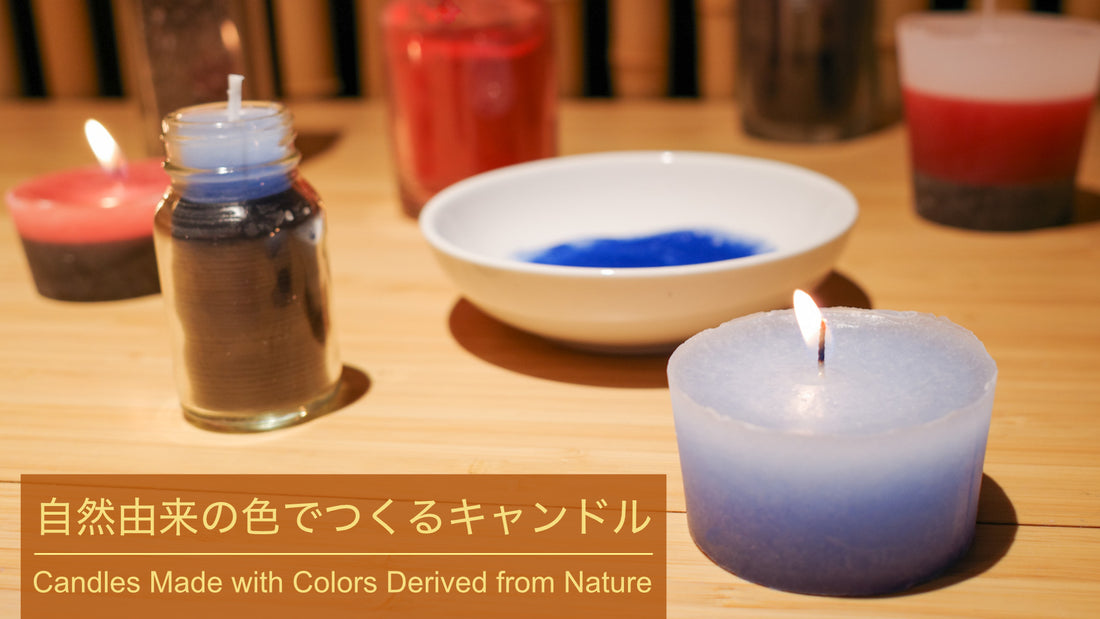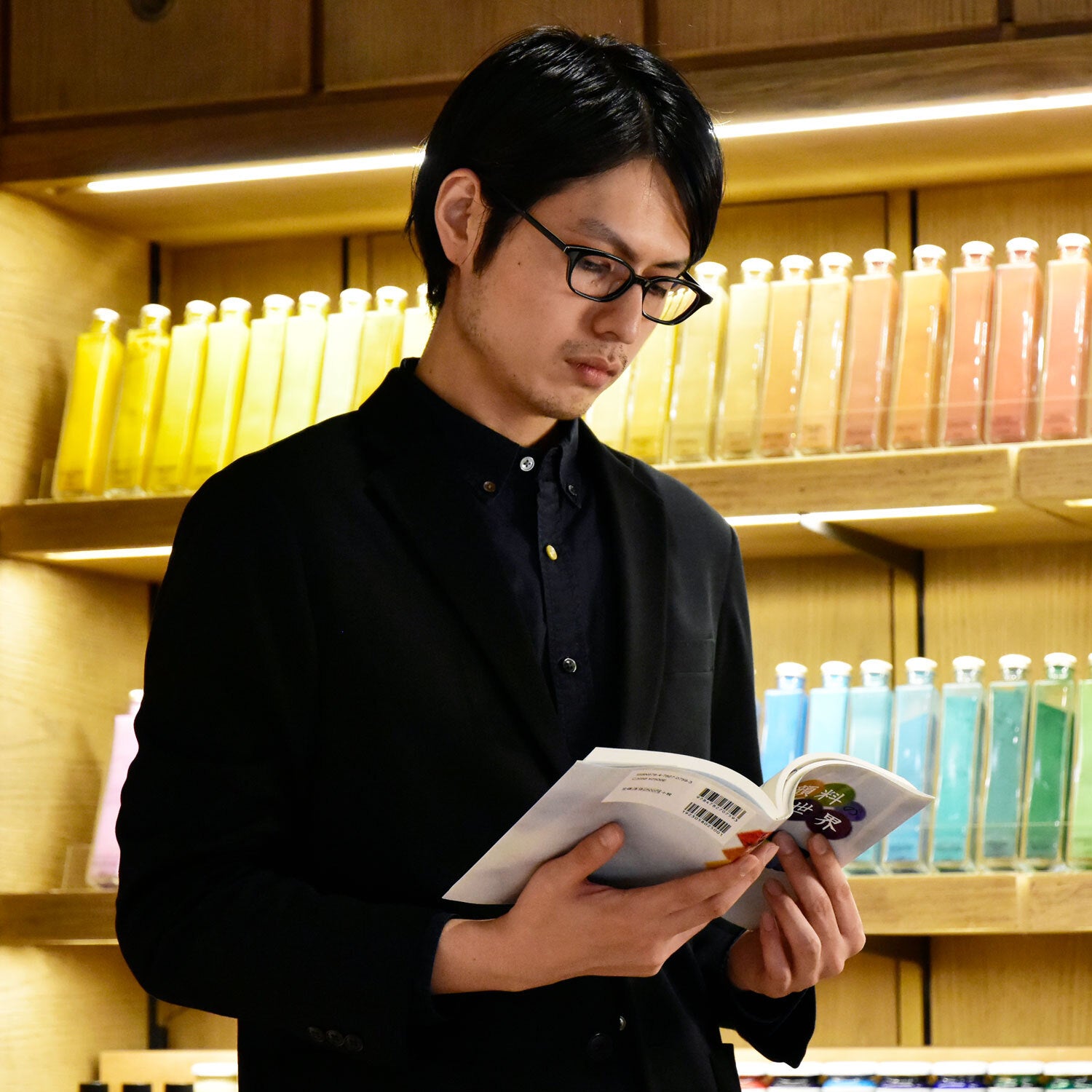PIGMENT TOKYO offers nearly 4,500 colors of pigments and each color is made from different raw materials. Among them, there are special kinds of pigments made with natural dyes.
Although natural dye-based pigments have lower lightfastness and less preservability compared to other pigments, their soft color tones and texture are irreplaceable with others.
In this article, I am going to demonstrate how to make candles with those natural colors.
First of all, let me introduce the color materials I used.
Cochineal dye is derived from dried scale insects found on cactus. We carry cochineal produced by Zecchi and Schmincke.
Next, we have Indigo which is an annual herb of the Polygonaceae family, of which leaves and stems are used as a dye. Its origin is believed to be southern China or the Indochina Peninsula and it was first imported to Japan in the Asuka Period (592-710) through mainland China.
Nowadays, synthetic dyes are mostly used for dyeing jeans but back then, natural indigo was more commonly used. However, our colorants are pigmented dyes, they cannot be used for dyeing.
The following list is the painting materials and tools I used for candle making.

・Wax for candles
・Colorants
・Cooking pots
・Beakers
・Paper cups (molds)
・Empty bottles
・Candle wicks
・Wooden sticks such as disposable chopsticks (for holding candle wicks)
・Glass rod
・Induction cooktop
*Work carefully to avoid burns when using fire.
In order to see what is going to happen when effect pigments are mixed with candles, I also tried to add Metashine Silver Coat MC5090PS and 153 Flash Pearl.
These are both silver-type effect pigments, but the Silver Coat MC5090PS has larger particles and is reflective, while the 153 Flash Pearl is finer and more powdery.
Let’s see whether there are differences between general pigments and effect pigments when they are mixed with wax.
Now, it is time to make some candles.
① Boil the wax in hot water and add pigments.
The first step is to boil the wax in hot water. This time, I prepared 400g of wax in order to make several candles to experiment with different colors. Since I am mixing multiple pigments, I want to avoid burning them so I use a beaker to boil in hot water.
Although it depends on the type of wax, the melting point is generally between 50°C and 60°C. However, if the temperature is too low, it may not form beautifully, so I suggest you heat it to about 70 to 75℃.
Next, add pigments to the melted wax. The necessary amount varies depending on the color material and color you want, so it’s better to begin by adding small amounts of pigments and stirring to check the color.
In my case, I added about one spoon for both Indigo and Cochineal pigments.

Adding Indian Indigo pigment from NAKAGAWA GOFUN ENOGU.

It turned out darker than what I imagined.

Cochineal is commonly used as a food additive and will turn bright red when mixed with wax.
② Pour the wax into the mold.
Carefully pour the wax into the mold (paper cup) without touching the wood sticks that hold the candle wick.
The wax will harden in about 1 to 2 hours at room temperature, so if you want to add more colors, please wait until the wax is completely solid before adding another layer of color.

I made a mini candle using a small pigment jar.

Cochineal colored wax in a paper cup. The Indigo color layer is at the bottom.
③Final step
Cut the surrounding paper cups with a cutter knife and remove them, and it is done!
This candle has three layers of colors, from bottom to top: Indian Indigo, Cochineal and 153 Flash Pearl.
The Indian Indigo turned out darker than it looked in the pigment bottle but the Cochineal appeared as vivid as it was. However, the effect pigment doesn’t seem to appear as glittery as I expected. I think this could be avoided by making a paste with oil-based medium and effect pigments in advance, or by adding crushed candles that have been mixed with pigment and hardened beforehand.

This candle is made of a mixture of Indian Indigo and Silver Coat MC5090PS at the bottom, while Cochineal and 153 Flash Pearl at the top. Although the brightness of both colors was increased by the effect pigments, Silver Coat MC5090PS did not seem to have any significant effect. 153 Flash Pearl could be mixed with the pigments in this way to give a visual change rather than using it by itself.

As an optional experiment, I made a candle using Lina Blue, the only edible color material among all the color products carried at PIGMENT TOKYO.
Lina Blue is a plant-based colorant that complies with the standards of the United States and Europe, as well as Japan, Korea, and Taiwan.
It is a natural blue colorant “phycocyanin” extracted from DIC Spirulina which has been cultured under controlled conditions. Moreover, it can be mixed with binders to create paint.
However, since this color does not have good lightfastness, it may fade if exposed to light continuously and is not suitable as a colorant for artworks to be installed permanently.
The heat resistance of Lina Blue is also very low, so there is a possibility of result fading. Let's see how it changes under the heat in candle making.
Here is Lina Blue on a plate. It looks as great as regular blue pigments. As a food colorant, it most closely resembles Brilliant Blue FCF.

This is how it looks in the melted wax.
At first, it kept a bright blue color but as it was heated, the blue seemed to gradually fade away. Also, it was difficult for the wax and pigment to disperse nicely and it took some time to stir.

And here is the result.
The upper part is Lina Blue and the lower part is a mixture of Indian Indigo pigment and Silver Coat MC5090PS. As I mentioned earlier in this article, effect pigments tend to precipitate at the bottom and by mixing them with Indian Indigo pigment, I was able to create a gradation of the colors.
Lina Blue also has precipitated so the blue color appeared gradually stronger toward the bottom.

Furthermore, assuming that the temperature of the wax was less than 100°C, Lina Blue does not completely fade after a certain amount of temperature in a short period. However, this is just information I examined while writing this article, so I strongly recommend that you test it before using it for your own practice.
Although I made candles using colored materials that are considered less harmful to human bodies, some pigments contain heavy metals that are not suitable for heating which will produce toxic smoke. Therefore, please be aware of whether the colors are safe to be heated when making candles.
I hope these color candles will warm you up this winter!
Translated by Atsumi Okano and Nelson Hor Ee Herng


